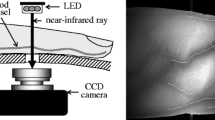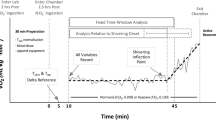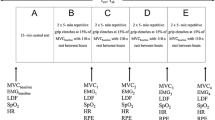Abstract
Cutaneous temperature sensitivity was tested in 13 male subjects prior to, during and after they breathed either a hypocapnic hypoxic (HH), or a normocapnic hypoxic (NH) breathing mixture containing 10% oxygen in nitrogen. Normocapnia was maintained by adding carbon dioxide to the inspired gas mixture. Cutaneous thresholds for thermal sensation were determined by a thermosensitivity testing device positioned on the plantar side of the first two toes on one leg. Heart rate, haemoglobin saturation, skin temperature at four sites (arm, chest, thigh, calf) and adapting temperature of the skin (T ad; degrees centigrade), i.e. the temperature of the toe skin preceding a thermosensitivity test, were measured at minute intervals. Tympanic temperature (T ty; degrees centigrade) was measured prior to the initial normoxic thermosensitivity test, during the hypoxic exposure and after the completion of the final normoxic thermosensitivity test. End-tidal carbon dioxide fraction and minute inspiratory volume were measured continuously during the hypoxic exposure. Ambient temperature, T ty, T ad and mean skin temperature remained similar in both experimental conditions. Cutaneous sensitivity to cold decreased during both HH (P<0.001) and NH conditions (P<0.001) as compared with the tests undertaken pre- and post-hypoxia. No similar effect was observed for cutaneous sensitivity to warmth. The results of the present study suggest that sensitivity to cold decreases during the hypoxic exposure due to the effects associated with hypoxia rather than hypocapnia. Such alteration in thermal perception may affect the individual’s perception of thermal comfort and consequently attenuate thermoregulatory behaviour during cold exposure at altitude.

Similar content being viewed by others
References
Astrup J (1982) Energy-requiring cell functions in the ischemic brain. Their critical supply and possible inhibition in protective therapy. J Neurosurg 56:482–497
Barnas GM, Rautenberg W (1990) Shivering and cardiorespiratory responses during normocapnic hypoxia in the pigeon. J Appl Physiol 68:84–87
Bonora M, Gautier H (1989) Effects of hypoxia on thermal polypnea in intact and carotid body-denervated conscious cats. J Appl Physiol 67:578–583
Bravenboer B, van Dam PS, Hop J, vd SJ, Erkelens DW (1992) Thermal threshold testing for the assessment of small fibre dysfunction: normal values and reproducibility. Diabet Med 9:546–549
Burke WE, Mekjavic IB (1991) Estimation of regional cutaneous cold sensitivity by analysis of the gasping response. J Appl Physiol 71:1933–1940
Cabanac M (1969) Plaisir ou Déplaisir de la Sensation Thermique et Homothermique. Physiol Behav 4:359–364
Cabanac M (1981) Physiological signals for thermal comfort. In: Cena K, Clark JA (eds) Bioengineering, thermal physiology and comfort. Elsevier, Amsterdam, pp 181–192
Cheung SS, Mekjavic IB (1995) Human temperature regulation during subanesthetic levels of nitrous oxide-induced narcosis. J Appl Physiol 78:2301–2308
Collins KJ, Exton-Smith AN (1983) Thermal homeostasis in old age. J Am Geriatr Soc 31:519–524
Collins KJ, Dore C, Exton-Smith AN, Fox RH, MacDonald IC, Woodward PM (1977) Accidental hypothermia and impaired temperature homoeostasis in the elderly. Br Med J 1:353–356
Collins KJ, Exton-Smith AN, Dore C (1981) Urban hypothermia: preferred temperature and thermal perception in old age. Br Med J (Clin Res Ed) 282:175–177
Collins KJ, Easton JC, Belfield-Smith H, Exton-Smith AN, Pluck RA (1985) Effects of age on body temperature and blood pressure in cold environments. Clin Sci (Lond) 69:465–470
Crawshaw LI, Nadel ER, Stolwijk JA, Stamford BA (1975) Effect of local cooling on sweating rate and cold sensation. Pflugers Arch 354:19–27
Findlater GS, Cooksey EJ, Anand A, Paintal AS, Iggo A (1987) The effects of hypoxia on slowly adapting type I (SAI) cutaneous mechanoreceptors in the cat and rat. Somatosens Res 5:1–17
Foray J (1992) Mountain frostbite. Current trends in prognosis and treatment (from results concerning 1261 cases). Int J Sports Med 13 [Suppl 1]:S193–S196
Fowler B, White PL, Wright GR, Ackles KN (1982) The effects of hypoxia on serial response time. Ergonomics 25:189–201
Fowler B, Taylor M, Porlier G (1987a) The effects of hypoxia on reaction time and movement time components of a perceptual-motor task. Ergonomics 30:1475–1485
Fowler CJ, Carroll MB, Burns D, Howe N, Robinson K (1987b) A portable system for measuring cutaneous thresholds for warming and cooling. J Neurol Neurosurg Psychiatry 50:1211–1215
Fowler B, Banner J, Pogue J (1993) The slowing of visual processing by hypoxia. Ergonomics 36:727–735
Fowler B, Prlic H, Brabant M (1994) Acute hypoxia fails to influence two aspects of short-term memory: implications for the source of cognitive deficits. Aviat Space Environ Med 65:641–645
Gautier H, Bonora M, Remmers JE (1989) Effects of hypoxia on metabolic rate of conscious adult cats during cold exposure. J Appl Physiol 67:32–38
Gautier H, Bonora M, Schultz SA, Remmers JE (1987) Hypoxia-induced changes in shivering and body temperature. J Appl Physiol 62:2477–2484
Golja P, Tipton MJ, Mekjavic IB (2003) Cutaneous thermal thresholds—the reproducibility of their measurements and the effect of gender. J Therm Biol 28:341–346
Gordon CJ (1997) The role of behavioral thermoregulation as a thermoeffector during prolonged hypoxia in the rat. J Therm Biol 22:315–324
Gordon CJ, Fogelson L (1991) Comparative effects of hypoxia on behavioral thermoregulation in rats, hamsters, and mice. Am J Physiol 260:R120–R125
Hansen AJ, Hounsgaard J, Jahnsen H (1982) Anoxia increases potassium conductance in hippocampal nerve cells. Acta Physiol Scand 115:301–310
Hensel H (1976) In: Zotterman Y (ed) Sensory functions of the skin in primates with special reference to man. Proceedings of the international symposium. Pergamon, Oxford, pp 331–353
Hicks JW, Wood SC (1985) Temperature regulation in lizards: effects of hypoxia. Am J Physiol 248:R595–R600
Iggo A, Paintal AS (1977) The metabolic dependence of primate cutaneous cold receptors [proceedings]. J Physiol (Lond) 272:40P–41P
Jamal GA, Hansen S, Weir AI, Ballantyne JP (1985) An improved automated method for the measurement of thermal thresholds. 1. Normal subjects. J Neurol Neurosurg Psychiatry 48:354–360
Kennedy RS, Dunlap WP, Banderet LE, Smith MG, Houston CS (1989) Cognitive performance deficits in a simulated climb of Mount Everest: Operation Everest II. Aviat Space Environ Med 60:99–104
Kenshalo DR (1976) In: Zotterman Y (ed) Sensory functions of the skin in primates with special reference to man. Proceedings of the international symposium. Pergamon, Oxford, pp 305–330
Krnjevic K, Leblond J (1989) Changes in membrane currents of hippocampal neurons evoked by brief anoxia. J Neurophysiol 62:15–30
Malvin GM, Wood SC (1992) Behavioral hypothermia and survival of hypoxic protozoans Paramecium caudatum. Science 255:1423–1425
Martin RL, Lloyd HG, Cowan AI (1994) The early events of oxygen and glucose deprivation: setting the scene for neuronal death? Trends Neurosci 17:251–257
Meh D, Denislic M (1994) Quantitative assessment of thermal and pain sensitivity. J Neurol Sci 127:164–169
Mekjavic IB, Sundberg CJ (1992) Human temperature regulation during narcosis induced by inhalation of 30% nitrous oxide. J Appl Physiol 73:2246–2254
Mekjavic IB, Passias T, Sundberg CJ, Eiken O (1994) Perception of thermal comfort during narcosis. Undersea Hyperb Med 21:9–19
Mekjavic IB, Savic SA, Eiken O (1995) Nitrogen narcosis attenuates shivering thermogenesis. J Appl Physiol 78:2241–2244
Mercer J (2001) Glossary of terms for thermal physiology. The Commission for Thermal Physiology of the International Union of Physiological Sciences. Jpn J Physiol 51:245–280
Nadel ER, Mitchell JW, Stolwijk JA (1973) Differential thermal sensitivity in the human skin. Pflugers Arch 340:71–76
Nelson PG, Frank K (1963) Intracellularly recorded responses of nerve cells to oxygen deprivation. Am J Physiol 205:208–212
Passias TC, Meneilly GS, Mekjavic IB (1996) Effect of hypoglycemia on thermoregulatory responses. J Appl Physiol 80:1021–1032
Pertwee RG, Marshall NR, Macdonald AG (1986) Effects of subanesthetic doses of inert gases on behavioral thermoregulation in mice. J Appl Physiol 61:1623–1633
Pierau FK, Wurster RD (1981) Primary afferent input from cutaneous thermoreceptors. Fed Proc 40:2819–2824
Rautenberg W (1990) Control of cardiorespiration during shivering thermogenesis in pigeons. In: Bligh J, Voigt K (eds) Thermoreception and temperature regulation. Springer, Berlin Heidelberg New York, pp 200–208
Tipton MJ, Golden FS (1987) The influence of regional insulation on the initial responses to cold immersion. Aviat Space Environ Med 58:1192–1196
Wood SC (1991) Interactions between hypoxia and hypothermia. Annu Rev Physiol 53:71–85
Acknowledgement
This study was supported, in part, by the Ministry of Education, Science and Sport of the Republic of Slovenia.
Author information
Authors and Affiliations
Corresponding author
Rights and permissions
About this article
Cite this article
Golja, P., Kacin, A., Tipton, M.J. et al. Hypoxia increases the cutaneous threshold for the sensation of cold. Eur J Appl Physiol 92, 62–68 (2004). https://doi.org/10.1007/s00421-004-1058-9
Accepted:
Published:
Issue Date:
DOI: https://doi.org/10.1007/s00421-004-1058-9




